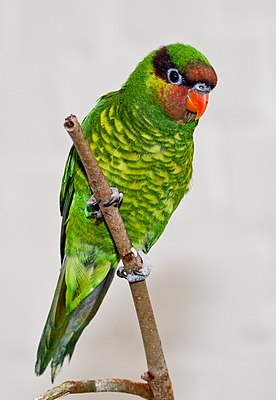Apolori
| Apolori | ||||||||||||
|---|---|---|---|---|---|---|---|---|---|---|---|---|

Apolori at London Zoo |
||||||||||||
| Systematics | ||||||||||||
|
||||||||||||
| Scientific name | ||||||||||||
| Trichoglossus johnstoniae | ||||||||||||
| Hartert , 1903 |
The Apolori ( Trichoglossus johnstoniae ), also called Mindanaolori , is a species of parrot from the genus of the wedge-tailed loris ( Trichoglossus ). It is endemic to the Philippines island of Mindanao . The species epithet honors the British aviculturist Marianne Johnstone, who first made it possible to breed Apoloris in England at the beginning of the 20th century. In 1903 the species was discovered by Walter Goodfellow on Mount Apo .
features
There are two subspecies, which differ only slightly from each other: The nominate form Trichoglossus johnstoniae johnstoniae reaches a size of 20 centimeters, a weight of 48 to 62 grams and a wing length of 110 to 115 mm. The plumage is generally green. The forehead and cheeks are rose-red. A dark purple band extends from the reins to the back of the head. The underside is yellow with a greenish wave pattern. The under wing coverts and the under tail coverts are greenish yellow. A yellowish band can be seen on the lower wings. The beak is orange-red. A dark gray eye ring runs around the red iris. The legs are greenish gray. The sexes look the same. The face of the juvenile birds is less pink. The eye stripe of the adult birds is replaced by a dull mauve-brown spot behind the eyes of the young birds. A gray-white eye ring runs around the brown iris. The beak is black-brown. In the subspecies Trichoglossus johnstoniae pistra , the red color on the face is duller. The purple eye stripe that runs from the reins to the back of the head is wider. The top is darker green and the yellowing on the underside is lighter and stronger.
distribution
Trichoglossus johnstoniae johnstoniae occurs in Mount Apo Natural Park , Kitanglad , Matutum and Piapayungan in central Mindanao, the subspecies Trichoglossus johnstoniae pistra on Mount Malindang in western Mindanao.
habitat
The Apolori lives in montane forests at altitudes of 1000 to 2500 m.
Way of life
The plumage provides good camouflage, so the species is difficult to observe when it is in the foliage of the trees. The Apolori goes in search of food individually, in pairs or in small schools of up to 30 individuals. The Apoloris fly quickly above the tree tops or in the canopy of leaves. The birds in a flock fly in close formation and the whirring beats of wings can be heard. At sunset, the lories come down to lower altitudes to seek their resting places. At sunrise they move back to higher forest regions. The diet consists of nectar, flowers, fruits, pollen and insects. Little is known about the reproductive behavior of the Apoloris in nature. Birds with enlarged gonads have been observed between February and April. Nests and eggs have not yet been discovered.
status
The Apolori is on the IUCN's early warning list . It is only frequent locally, but no inventory figures are available. The main threats come from being caught for the ornamental bird trade and from habitat loss.
literature
- Thomas Arndt: Lexicon of Parrots . Arndt Verlag, 2001.
- Joseph M. Forshaw: Parrots of the World: An Identification Guide . Princeton University Press, Princeton, New Jersey / Woodstock, United Kingdom 2006, ISBN 0-691-09251-6 .
- J. Del Hoyo, A. Elliot, J. Sargatal (Eds.): Handbook of the Birds of the World. Volume 4: Sandgrouse to Cuckoos . Lynx Edicions, 1997, ISBN 84-87334-22-9 .
Web links
- The Apolori on Birdlife International
- Lexicon of Parrots - Johnstone's Lorikeet
- Videos, photos and sound recordings for Trichoglossus johnstoniae in the Internet Bird Collection
- Trichoglossus johnstoniae inthe IUCN 2013 Red List of Threatened Species . Listed by: BirdLife International, 2012. Retrieved October 7, 2013.